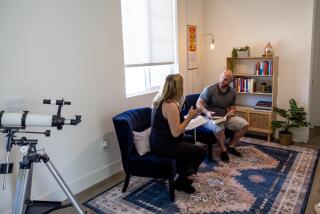Families Join Forces, Buy Property, Build Homes
For nearly 20 years, Margarita and Sam Revelas have lived in a small, rented clapboard house on the east side of Wilmington, a neighborhood that is dotted with oil wells and sliced by the tracks of the Santa Fe railroad.
It is a neighborhood where many people find home ownership out of reach. And the Revelases, with five children, never expected to be an exception. âWith these prices,â said Sam Revelas, âwhoâs going to afford to buy a home?â
But the couple will soon take the home ownership plunge as part of an unusual do-it-yourself project that will improve the lot of 19 families in east Wilmington, as well as the neighborhood itself.
The project began more than two years ago when the Revelases joined a group of Wilmington residents who pooled their money--$15,000 apiece, much of it borrowed--to get into the house-building business.
In addition to helping themselves, they wanted to show bankers, developers and city officials that there is a market for single-family homes in Wilmington--even in east Wilmington, where junkyards, abandoned cars and gang graffiti are an integral part of the landscape.
Construction Experience
With experience in neither real estate investment nor development, they formed a limited partnership and used the more than $250,000 that they had raised for a down payment on three acres of land at L Street and McFarland Avenue, on which they proposed to build single-family homes. As blue-collar workers, many with experience in construction, they planned to cut costs by doing some of the work themselves.
They named it Home Owners Partnership.
Until recently, others called it folly.
But now, after numerous delays and pitfalls, Home Owners Partnership is beginning construction. The group has blueprints, a general contractor and financing--a $2.2-million construction loan from the Bank of San Pedro. The sewer line was laid last week, and general partner Peter Mendoza says workers will soon begin pouring the foundations for the homes.
From his back yard, Sam Revelas can look across the railroad tracks and watch the work progress. In a recent interview, he searched for words to convey a very simple desire: to own property.
âThis Is My Houseâ
âItâs something that you have here, inside,â he said, tapping his chest with his fist. âThis is one of the goals in life, to be able to own a home, to have something that we always wanted to have, a place where our children can grow up and say, âThis is my house.â â
Technically, the development, which Mendoza hopes will be completed by Christmas, is a condominium project. That designation is necessary because the group does not own enough land to build 19 single-family houses and meet the city zoning code. But Mendoza says it gives the group an added benefit: a condominium association, through which upkeep of the development can be controlled.
For his full-time work on the project, Mendoza will earn 10% of the difference between the cost of building each home and its appraised value. He said most of the homes will cost about $120,000 to build and will likely be valued at about $160,000. The majority of the stucco, tile-roofed houses will be one story, although a handful of investors will get more expensive, two-story homes.
Not all of the investors are first-time buyers and not all live in the community. Some, such as Olivia Fernandez, say they see the project as a solid investment, as well as a way to improve their community.
Fernandez said: âIt was a chance to prove that single-family housing is still desired by people in the community as opposed to apartments.â
Two Trends
Home Owners Partnership is an outgrowth of two important movements in Wilmington: the slow-growth movement, and a trend toward neighborhood empowerment.
The trend began in 1985 with establishment of the Wilmington Home Owners. Residents, seeing that their community was overrun with apartment developments as well as pollution, truck traffic and industrial blight, banded together. Their first major victory came in March, 1986, when they persuaded city officials to enact a moratorium on building apartments.
Eight months after the moratorium was enacted, Home Owners Partnership was born, with Mendoza--who has been president of the Wilmington Home Owners since the groupâs inception--at the helm.
There were dozens of obstacles to overcome.
Among them were problems with Exxon Corp., which owned two oil wells on the property and eventually agreed to cap one; with the title search, which was complicated because of oil rights; with the city building and zoning code, and with the bank, which based its financing on the partnership redesigning the project with smaller houses.
Tired of Waiting
As delays mounted, some investors also grew frustrated. They watched home prices shoot up all around them. Some dropped out.
âIt was always waiting, waiting, thinking we could buy that house right now instead of being in this project,â Eliseo Sanchez said. He and his wife, Ana, stuck with the project, despite criticism from friends and relatives who âthought we were just throwing our money away.â
Those involved agree that it was the people who didnât have a choice, people like Sam and Margarita Revelas, who could not afford to buy a house any other way, who kept the faith--and kept the others involved. Revelas said he never had a doubt about the project--even when a potential buyer offered the group more than $1 million for the land that they had bought for $600,000 a year earlier.
âItâs something I believed in since the beginning,â he said. âI was one of the many that says, âNo thank you, you can keep your money. We want to see this thing through.â â
More to Read
Sign up for Essential California
The most important California stories and recommendations in your inbox every morning.
You may occasionally receive promotional content from the Los Angeles Times.






